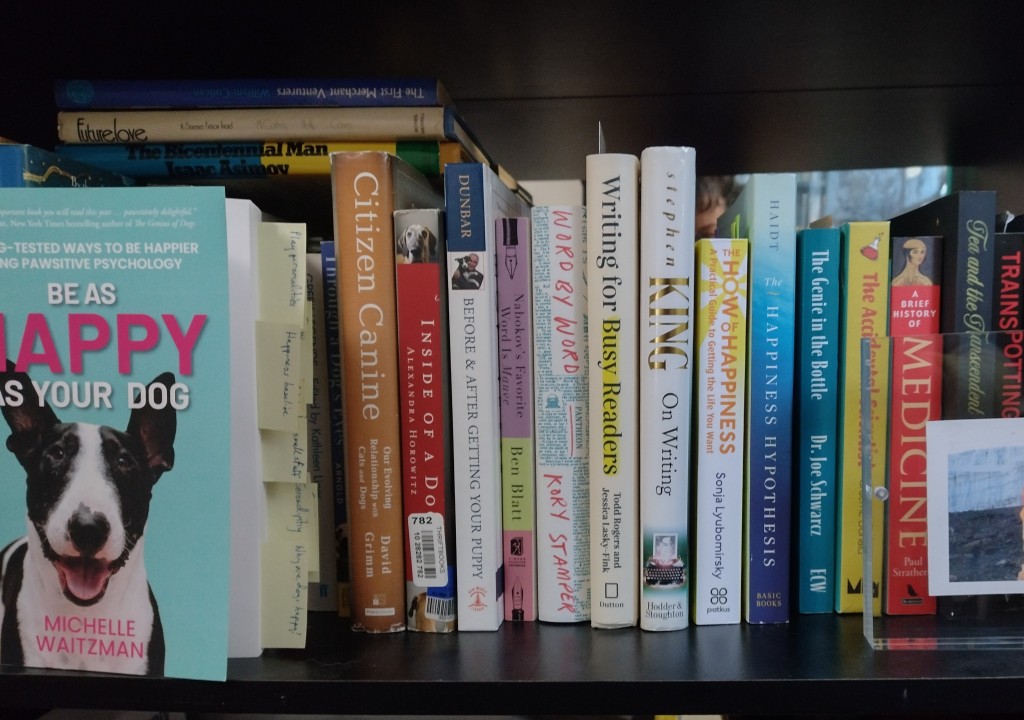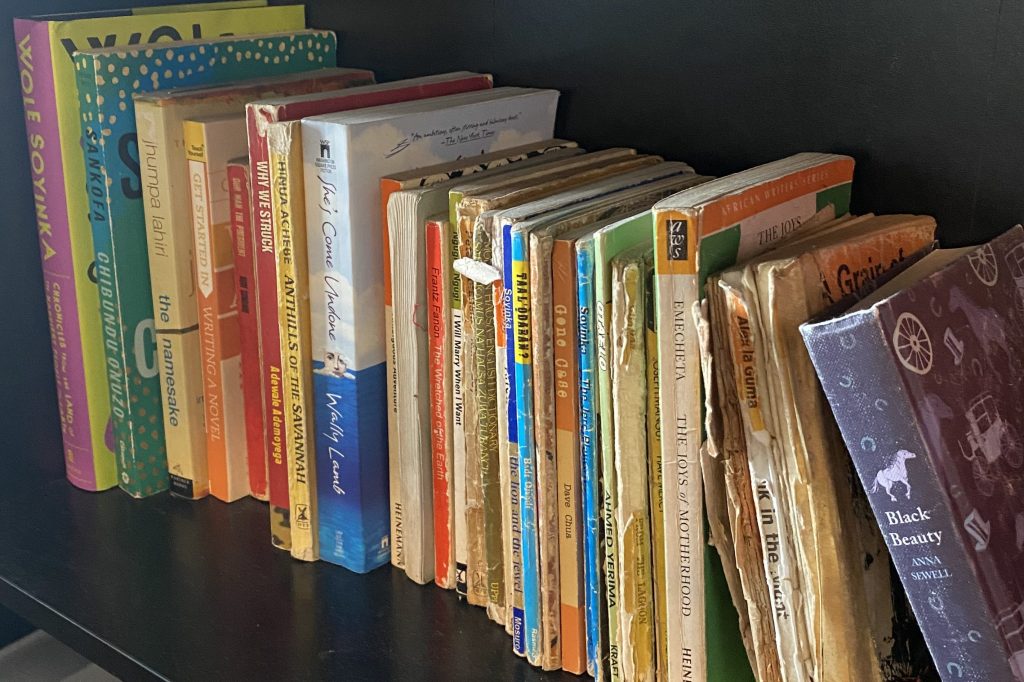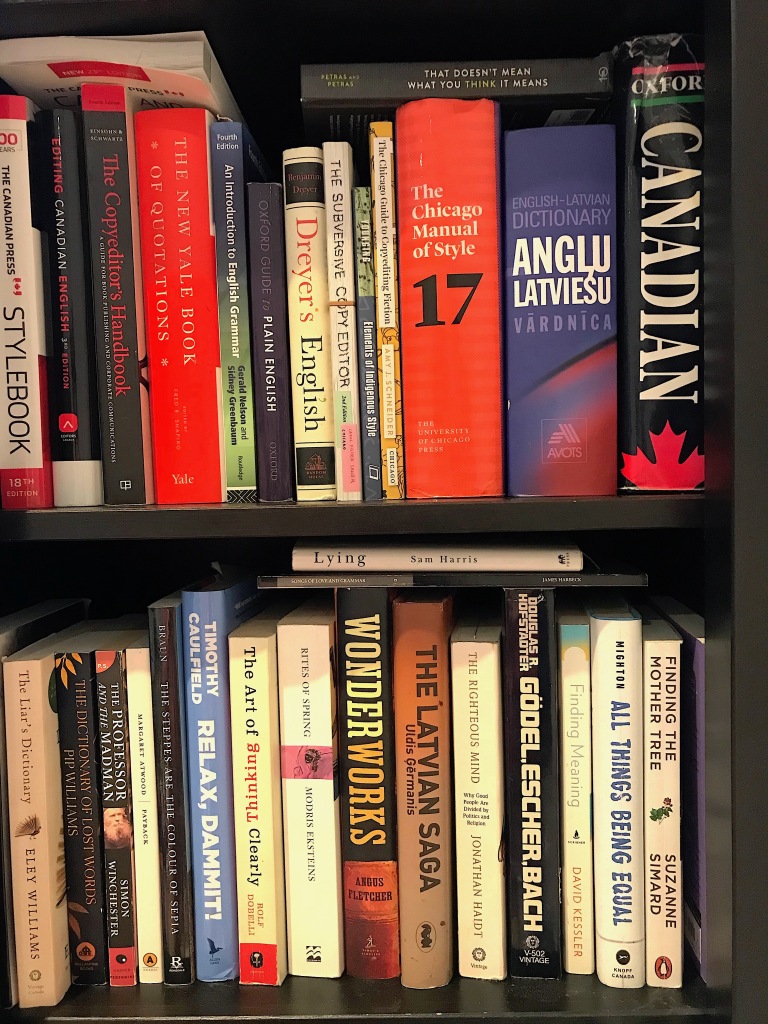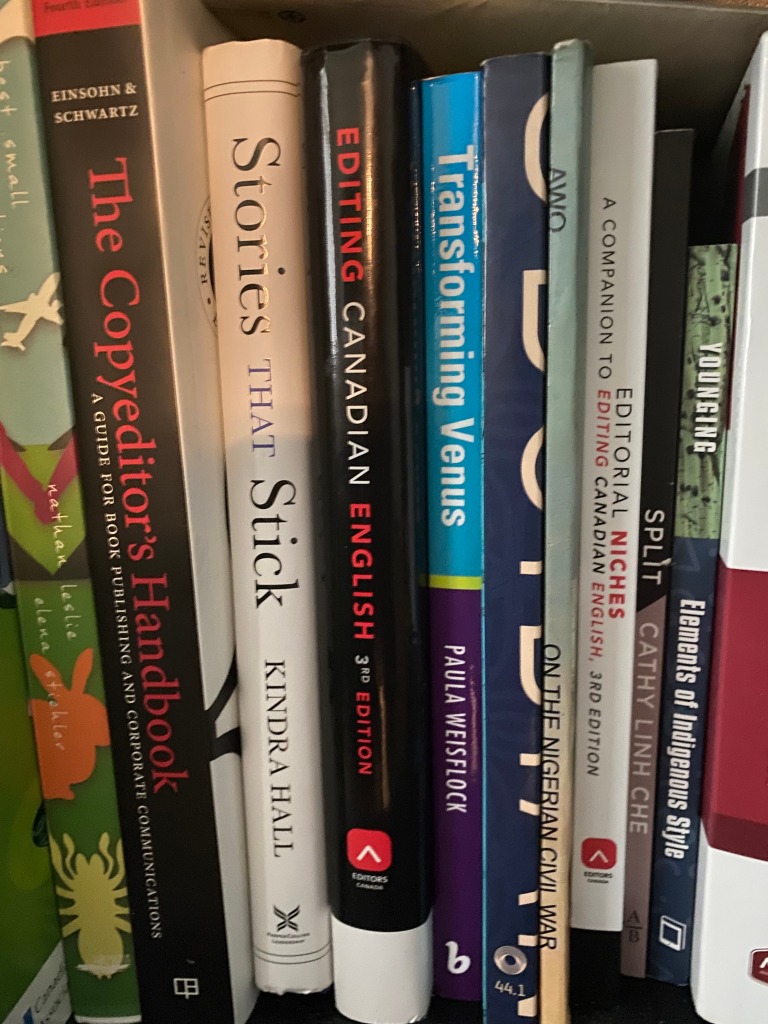In this column, members of the editing community share what’s on their (physical) bookshelves and highlight a few notable titles. In our previous instalment, editors shared such treasures as Craft in the Real World by Matthew Salesses and Julia Cameron’s The Artist’s Way: A Spiritual Path to Higher Creativity. If you’d like to show us your bookshelf, or part of it, let us know!
Michelle Waitzman (she/her) is a plain language consultant and trainer, non-fiction author, writer, and editor. Her bookshelf is in Scarborough, Ontario.

This shelf has my word-nerd books on it, along with books on other non-fiction topics I’m obsessed with. I have another bookshelf with my main reference books (dictionaries, style guides, etc.). Here are a few less-known titles that I think other editors might enjoy.
Writing for Busy Readers: Communicate more Effectively in the Real World is a recent title by Todd Rogers and Jessica Lasky-Fink from Harvard University. Rogers is a professor and Lasky-Fink is a research director. Their book is aimed mainly at business people who need to communicate with colleagues and stakeholders. Unlike most writing guides, they focus on the reality that most readers are not all that interested in reading what you write; you are competing with millions of distractions for their attention. They describe six principles of effective writing to help writers get their message through to readers. If you work with corporate clients (or struggle to write effective emails, newsletters, blog posts, or other content yourself) this book is a practical and valuable addition to your bookshelf.
Nabokov’s Favorite Word is Mauve: What the Numbers Reveal About the Classics, Bestsellers, and Our Own Writing looks at books in a unique way—through the lens of data analysis. Author Ben Blatt uses his skills as a data journalist to find patterns and uncover biases using a data set of 15,000 books, mainly from the twentieth and twenty-first centuries. He compares the word choices of male and female authors, investigates whether you can tell which bestselling books were ghostwritten, analyzes differences between American and British author voices, and much more. I wrote a review of this fascinating and surprising book in a previous blog post.
Any editor who has dreamed of working on a dictionary can take a peek behind the scenes in Word by Word: The Secret Life of Dictionaries by Merriam-Webster lexicographer Kory Stamper. Stamper provides a lot of insight about how a modern dictionary is updated and the criteria for deciding when to include a new word or an additional definition. It’s a wonderful antidote to the stereotype that language enthusiasts are pedantic and old-fashioned. Readers also get a glimpse into the day-to-day happenings at a dictionary publisher, and Stamper doesn’t hold back on sharing her personal quirks and experiences. I also wrote a review of this book in a previous blog post.
Vilma Indra Vītols is a freelance editor and opera singer, and a member of PLAIN (Plain Language Association International). Her bookshelf is in Toronto.
My bookshelf contains many of the usual suspects that others have mentioned before, but I nonetheless give shoutouts to Dreyer’s English, which first showed me that editing could be funny, and The Copyeditor’s Handbook by Amy Einsohn, which was my gateway into “serious” editing, and which I consult regularly.
Here are three other fun word books kicking around on my shelf:
I have not yet had need as an editor to consult The New Yale Book of Quotations, edited by Fred R. Shapiro, but it’s fun to flip it open at random and read. It includes a section on Anonymous (who, according to Virginia Woolf, “was often a woman”) and a list of quotations that have historically been attributed to famous men, but which were in fact made by unfamous women.
That Doesn’t Mean What You Think It Means: The 150 Most Commonly Misused Words and Their Tangled Histories, by Ross Petras and Kathryn Petras, is a pocket-sized book (if you have big pockets) about words that bemuse (or is it amuse?) even the most educated among us.
Songs of Love and Grammar, by James Harbeck, with illustrations by Jonathan Lu, is a delightful collection of poems about, well, love and grammar. Each poem, dressed up as a romantic interlude, grapples with a feature of English, with comic and often naughty results. One of my favourites is a poem called “Were or was it so,” about the subjunctive, “the mood that sets dreams apart from past regrets.”
Lola Opatayo is a stylistic and structural editor. Her bookshelf is in Surrey, British Columbia.

Some of the books on my bookshelf have travelled across mountains and seas. They are souvenirs from different times and a source of comfort when I need them. I read The Joys of Motherhood: A Novel by Buchi Emecheta (almost) every three years. It’s a reminder that mothering my children includes loving myself. A Grain of Wheat by Ngũgĩ wa Thiong’o is a gift from my father. I can’t remember how many times I’ve read it, but I’ve patched it several times. The Lion and the Jewel by Wole Soyinka reminds me that, as my people say, what an older person sees sitting, a young person cannot glimpse from the top of a tree. It centres me.
Because I often work with creative writers and novelists, I consider it important to read resources that will improve my editing skills in this regard. There’s a creative writing journal (Obsidian: Literature & Arts in the African Diaspora) on my bookshelf that I consult regularly and a writing resource (Stories that Stick by Kindra Hall) that I bought recently.
Also on my bookshelf are my editing resources. The Copyeditor’s Handbook, which I’ve found very helpful, is great for refreshing my memory of proofreaders’ marks and other technicalities I’m unsure of. Editorial Niches: A Companion to Editing Canadian English, 3rd Edition is a resource I often consult for Canadian spellings. As someone who spent most of her career editing British English, I’ve found this book to be quite helpful. Elements of Indigenous Style: A Guide for Writing By and About Indigenous Peoples by Gregory Younging is a critical guide on writing or editing content regarding Indigenous Peoples. I highly recommend it to anyone who’s editing or writing such content.
This article was copy edited by Jane Hodgkinson.


